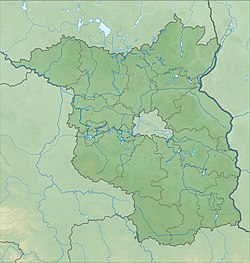Megalithic systems from Brüssow-Hammelstall
| Megalithic systems from Brüssow-Hammelstall | ||
|---|---|---|
|
The dolmen of Brüssow-Hammelstall |
||
|
|
||
| Coordinates | 53 ° 22 ′ 42.8 " N , 14 ° 6 ′ 41.5" E | |
| place | near Brüssow , Brandenburg , Germany | |
The megalithic systems of Brüssow-Hammelstall are located in a forest south of Brüssow in Brandenburg . Brüssow is located north of Prenzlau , in the area of the Märkische Eiszeitstraße , only a few kilometers from the border with Western Pomerania . A nature trail is laid out in the forest with a stone box and an extended dolmen . The northeast of the district of Uckermark and the area north of it is unusually rich in stone boxes.
The enlarged dolmen
The dolmen, made of granite boulders , is located on the Hammelstaller Berg. The megalithic system of the funnel beaker culture (TBK) is surrounded by a low round hill. The internal dimensions of the chamber are 2.5 × 0.9 m. The north-eastern narrow side is formed by the end stone, the two long sides consist of two 1.15 m and 1.45 m high bearing stones. On the supporting stones are two capstones weighing about four tones. The entrance is on the south-western narrow side. A threshold stone was not found. The easternmost German facility of this type, first mentioned in 1845, was already disrupted in the 19th century (Zeitschr. F. Ethnologie von 1891 p. 487). Only a few vessel fragments from the TBK were preserved. Around 1900 the dolmen was reconstructed at the instigation of the Uckermark Museum and History Association.
The stone box
The stone box from Brüssow-Hammelstall, which was only discovered in 1976, is located in a hill made of large boulders and has two cap stones. The block box, which is closed on all sides, is sunk into the ground and faces northwest-southeast. Three sides are made of thick stone blocks, the south-eastern narrow side of a thin stone slab. The floor of the chamber was paved with red sandstone , over which a clay screed was spread. The box was dug up. There were skeletal remains of at least three people in the chamber. The stone box probably comes from the early TBK. However, it was used again. The ceramic additions found are assigned to the Havelland culture . They consist of a mug with a handle and a small ornate hanging vessel. Nearby are the 15 Wollschow stone boxes.
literature
- Eberhard Kirsch, Contributions to the older funnel cup culture in Brandenburg. Potsdam 1994.

